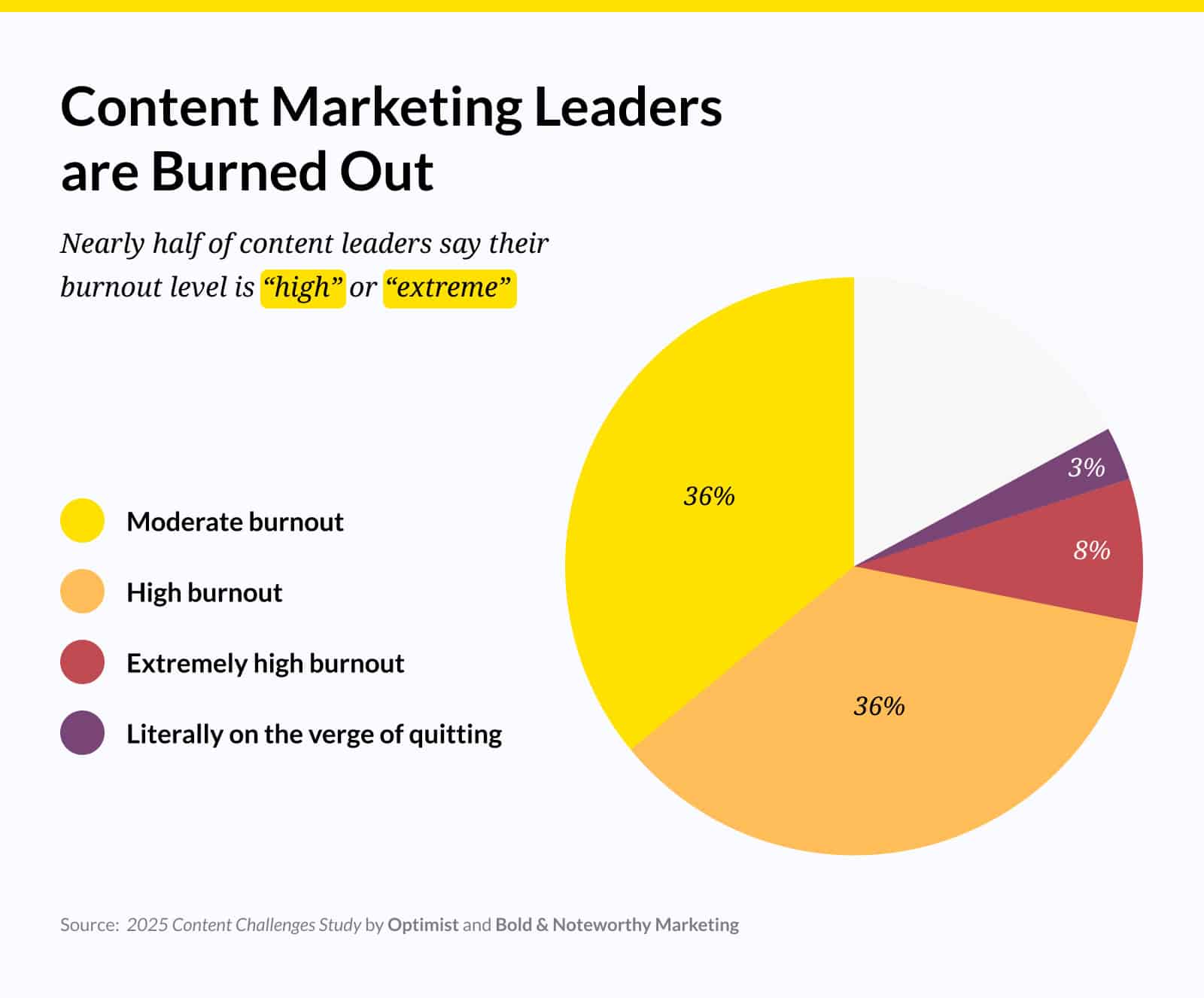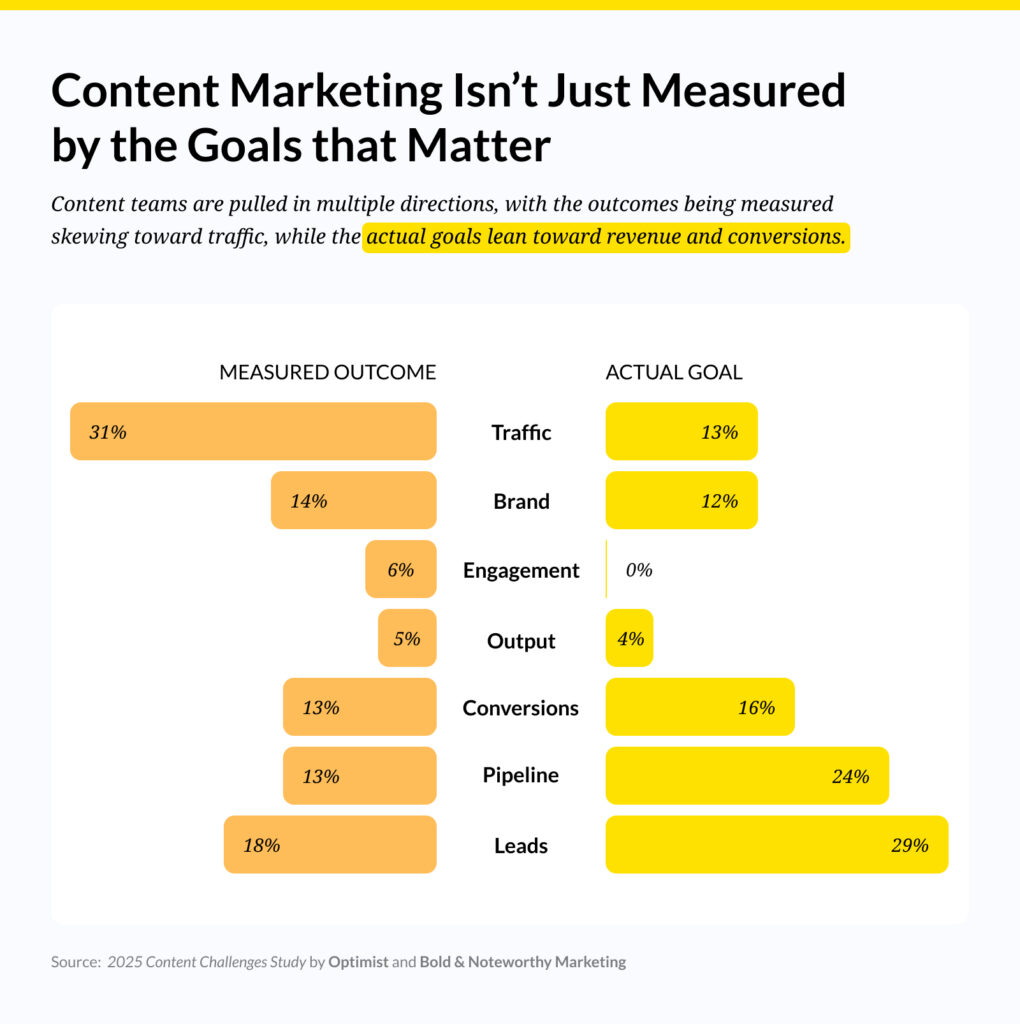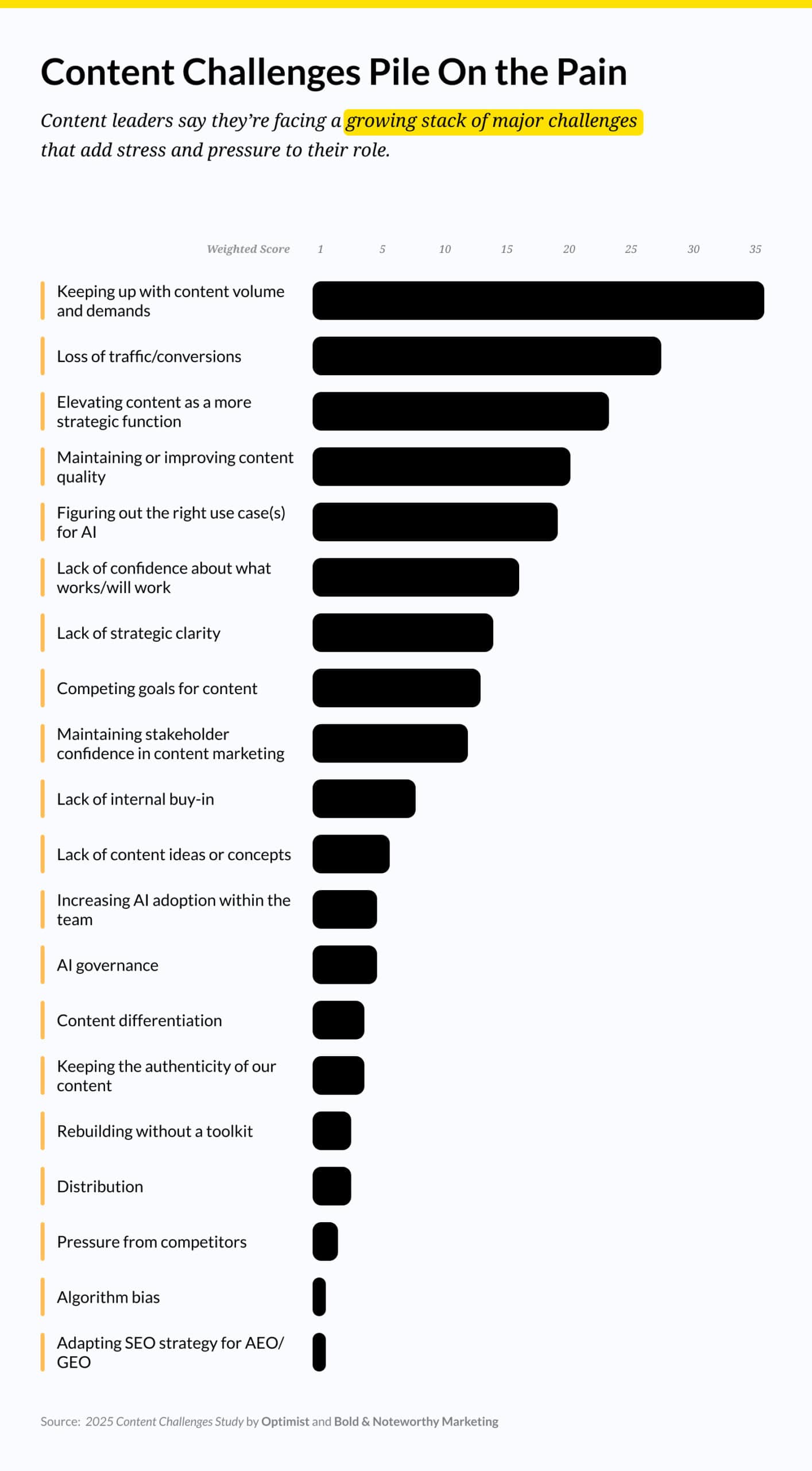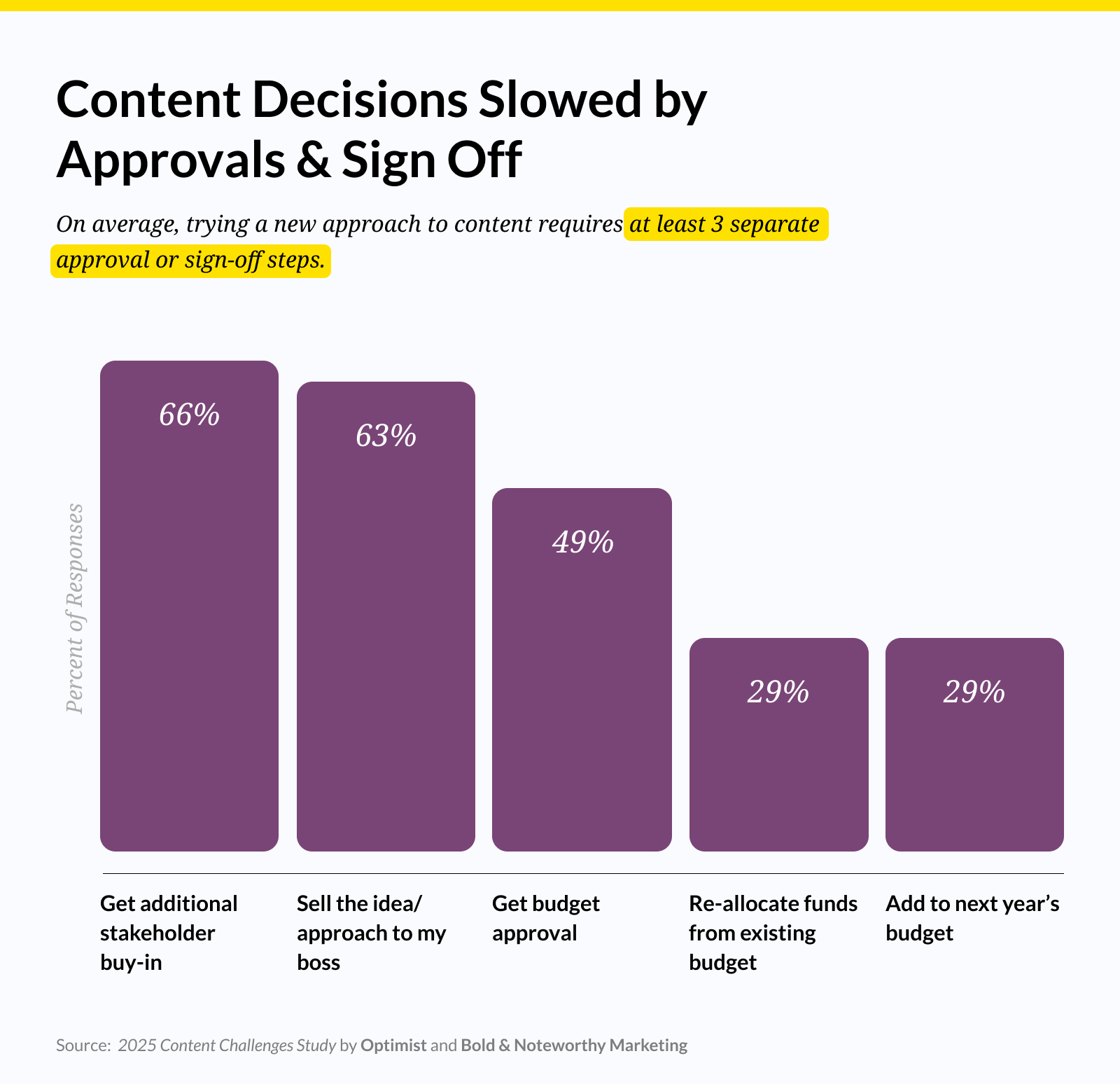Content marketers don’t just perform under pressure. They come alive.
They turn confusion into clarity, and transform chaos and doublespeak into brands and movements that fuel sustained growth.
So when content professionals tell you they’re burned out?
Everyone in marketing should be leaning in.
Everything we thought we knew about how content drives growth is being upended by AI.
The businesses and careers that were built around those top-of-funnel keyword posts? All the traffic, brand impressions, leads and pipeline fueled by a best-in-class SEO program?
They’re not dead. But they’re also not coming back.
Meanwhile, the professionals who are best positioned to navigate these major shifts say they’re being stretched between increasingly hard-to-reach goals — and maybe worst of all, struggling to find a place at the table when it’s time to build the new strategy.
Those are the takeaways from the 2025 Content Challenges Study by Optimist and Bold & Noteworthy Marketing. We surveyed 50+ content leaders across different industries and verticals, working in companies ranging from 50 employees to more than 5,000.
As practitioners ourselves, we understand the struggle. If you feel the burn too, we’d love to hear more about your challenges, and dig into real solutions.
We’re hosting a free, live webinar that will trace the steps that led us to this crisis in content, and look ahead to what’s next: how content marketers can escape the treadmill of uncertainty and build a sustainable, strategic plan for our new reality.
The Burnout Factor

Almost half (47%) of the leaders we surveyed placed themselves in the high to extreme burnout category. Another third reported “moderate” burnout. Only 14% said their burnout was low.
A few even admitted they’re literally on the verge of quitting. At these levels, you have to consider burnout a baseline condition for running content marketing teams today.
Why? Because the job has become unsustainable.
They’re asked to do more with less. To deliver brand visibility and pipeline growth at the same time, to chase traffic while SEO declines, to balance the needs of buyers and the input of stakeholders, and to fight uphill battles for budget and internal buy-in.
It’s no wonder so many are tapped out.
“[I wish we could] spend time and effort on clarifying and aligning everybody on market orientation…
…Then use this damn information to start doing the RIGHT things (which might mean: fewer things) to help the business grow.”
Stretched Between Goals: Reach vs. Revenue

Content professionals are used to serving multiple needs and fueling virtually every initiative in the business. Reach, impressions, traffic, form-fills, leads, pipeline: more is more, right?
But without priorities that match their actual goals, content teams are being set up to burn out.
When asked to name the top three outcomes they’re measured on, content leaders leaned toward reach: traffic, brand awareness, engagement.
But when asked to pick their primary goal, nearly 70% said revenue was the North Star.
“Stop prioritizing arbitrary content cadences at the expense of strategy.”
For years, those goals have been more or less in sync. More traffic means more form-fills, more leads, and more revenue.
But AI’s rapid disruption of traditional search is actually decoupling reach from revenue in many sectors. So clawing back impressions on Google or getting more mentions in ChatGPT simply won’t drive audiences to your platforms the way SEO used to.
And too often, content teams are so consumed with leadership panic about traffic declines that there’s not enough bandwidth to experiment with new approaches for driving reliable revenue. They’re stuck in a tradeoff between the immediate indicator (reach) and the ultimate goal (revenue). Either way, content leaders are left holding the bag if the numbers don’t go up.
This is a key driver of burnout. Teams are stretching themselves to cover the full spectrum of brand-to-demand activities, but they know their fate ultimately hinges on pipeline.
So make sure your expectations align with reality, especially in a world where cheap and easy site traffic is steadily drying up.
The Challenge Pile-On

If balancing reach and revenue weren’t enough, content leaders face a stack of additional challenges.
Our survey found:
- Volume pressure. The #1 challenge overall is simply keeping up with the demand for content. Small and large teams alike feel perpetually behind.
- Strategic invisibility. Elevating content as a true strategic function ranked high across company sizes. Leaders feel siloed and under-recognized.
- Declining performance. Midsize companies especially worry about the “loss of traffic and conversions” as traditional SEO strategies yield less return.
- Quality concerns. Large teams in particular struggle to maintain consistent quality at scale.
- AI uncertainty. Small teams are anxious about how to use AI effectively without wasting effort or sacrificing quality.
These aren’t separate issues. They layer on top of each other. Content leaders aren’t just tired — they’re stretched across competing priorities, with no clear path forward.
“We’re pulled in so many directions by competing ‘priorities; that it’s impossible to plan anything; let alone have any real impact.”
What Leaders Really Want

If content leaders could wave a magic wand, what would they fix first?
Our survey asked this exact question to gauge the most pressing problems and needs. We analyzed the responses and categorized them into general themes to understand the trends.
The answer might surprise you. It’s not budget. It’s not headcount. It’s not shiny new tools.
The #1 wish was internal alignment (23%). In other words: a seat at the table.
Close behind:
- Strategic elevation (17%) — content seen as a driver of business strategy, not just a service desk.
- Reach/distribution (14%) — better ways to get content in front of the right audiences.
- Measurement/attribution (14%) — clarity on impact.
- Resourcing/capacity (11%) — yes, more people would help, but it’s not the biggest pain point.
The data says it clearly: leaders don’t want to churn faster on the hamster wheel. They want influence. They want to shape strategy, not just execute it.
“Give us a stronger voice in overall strategy; across channels and campaigns.”
Looking at the specific language, it’s even more clear that this isn’t just a nice-to-have. It’s a feeling of borderline desperation. Lack of authority and autonomy is a major problem.
Some of the responses:
- “Shift the organizational value of content. We’re rarely driving messaging and positioning; but we should be.”
- “Give us a stronger voice in overall strategy; across channels and campaigns.”
- “Stop prioritizing arbitrary content cadences; like putting out our monthly minimum of SEO blogs; at the expense of strategy.”
- “Get us hyper-focused on a real content strategy and then stick to it long enough to see if it’s working. Instead; we’re pulled in so many directions by competing ‘priorities’ that it’s impossible to plan anything; let alone have any real impact.”
- “Spend time and effort on clarifying and aligning everybody on market orientation. Then use this damn information to start doing the RIGHT things (which might mean: fewer things) to help the business grow; instead of random acts of marketing that look good; feel good; and eventually amount to very little.”
Death by Approval Cycle

The flip side of too little strategic buy-in is endless reviews, bottomless approvals, and constant micromanaging of content projects and outputs. We asked content leaders: If you wanted to try a new content marketing approach, which steps would likely be involved to get started?
- 66% would have to secure additional stakeholder buy-in.
- 63% would need to sell the idea to their boss.
- 49% would have to win budget approval.
On average, content marketers say they’d need to clear two to three additional hurdles before trying something new.
“[I wish I could] obtain executive alignment without having to go through hours upon hours of quantitative research…”
That kind of conservative process leaves content professionals unable to respond quickly to the head-spinning changes that are reshaping content marketing. Without the freedom to move quickly, creativity gets strangled. Innovation stalls. Leaders burn out.
If you’re a content leader, this complaint is probably nothing new. But this moment in particular demands new approaches and bold experiments, and content leaders need to be freed to try things instead of worrying about the latest executive feedback loop.
It’s no wonder many describe testing new approaches as a “career-risking move.”
The Bigger Picture
Here’s the state of content leadership in 2025:
- Burnout is rampant. Nearly half are high-to-extreme.
- Revenue dominates. Leaders are judged first and foremost on pipeline impact.
- Challenges stack. Volume, performance decline, strategic invisibility, and AI uncertainty weigh on everyone.
- Influence is missing. Leaders crave alignment and a voice in strategy.
- Approvals choke innovation. The risk isn’t just external market shifts — it’s internal red tape.
The throughline is unmistakable: content leaders are stuck in systems that demand too much, grant too little authority, and provide little protection against burnout.
Building Toward Better
The data tells us what’s broken. But it also hints at what could be fixed.
Content leaders don’t want to flood the world with more assets. They want to create smarter, more strategic content that has both reach and revenue impact. They don’t want endless approval cycles. They need alignment, authority, and trust.
If companies want content programs that can adapt and thrive, they need to stop treating content teams like service desks and start treating them like strategic partners.
Because the truth is, the old playbooks don’t work anymore.
- The “more content, faster” model has maxed out.
- The “just SEO it” approach is faltering.
- The “gate everything” funnel is obsolete.
The future of content leadership will belong to the teams that can build sustainable systems: workflows that balance reach and revenue without burning people out.
Until then, content marketers aren’t just tired. They’re sounding the alarm.
And we should listen.
–
What Comes Next
In October, we’re hosting a live workshop to explore these trends in more detail and — more importantly — answer the most pressing question…
How do we fix it?
Join us: Content in Crisis: How Content Marketing Became So Unsustainable (and What We Can Do to Fix It)